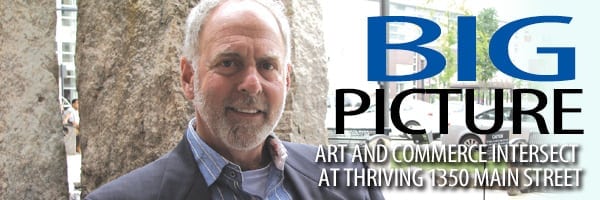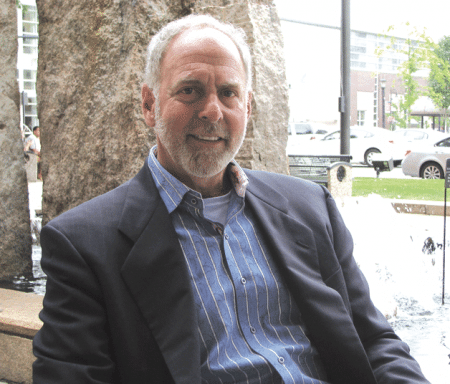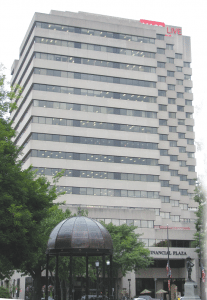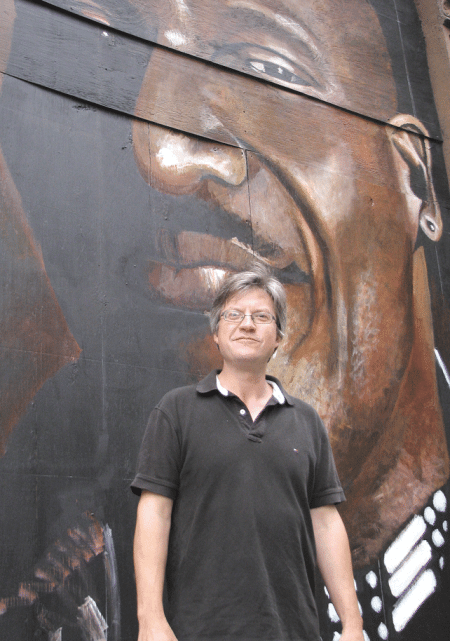
Big Picture
Art and Commerce Intersect at Thriving 1350 Main Street

Evan Plotkin says 1350 Main Street, with its robust leasing activity and artsy “vibe,” is a microcosm of what could happen across downtown Springfield.
Take 1350 Main Street, or One Financial Plaza, in downtown Springfield, which was recently branded the MassLive Building after its newest tenant, which is leasing 11,000 square feet of space and paying for the right to emblazon the tower with its logo. MassLive is among several companies and colleges that have recently forged deals at 1350 Main, drawn by its location, its noteworthy art galleries (more on that later), and what Evan Plotkin describes as a palpable “vibe” at the site.
“One of the fascinating things about this building is that it represents, in my mind, a microcosm of an economic-development concept that is arts-driven,” said Plotkin, president of NAI Plotkin, which co-owns the property. “When we acquired this property in 2007, the storefronts [on the first floor] were empty. We made major improvements in the plaza, including bringing the fountain back, putting in benches, and creating an environment conducive to gathering.”
That’s quite a contrast to seven years ago. When NAI Plotkin invested in 1350 Main, occupancy was 34%, the café now in the lobby was just a dark space, and there wasn’t much reason anyone would want to be on the property if they didn’t work in the tower, he said. “Most companies we approached said there was not enough foot traffic, and they would not be willing to make an investment.”
 But some of the more recent tenants — like the Baystate Innovation Center, which will move in around Nov. 1; Bay Path University, which leased space last year; 180 Fitness, which opened its doors on Jan. 1; and MassLive — say that’s changed dramatically.
But some of the more recent tenants — like the Baystate Innovation Center, which will move in around Nov. 1; Bay Path University, which leased space last year; 180 Fitness, which opened its doors on Jan. 1; and MassLive — say that’s changed dramatically.
“What I’m hearing over and over again is that what we’ve done here is build a community in this building,” Plotkin said. “That happens because we’re getting people out of their offices, and they’re able to interact with each other, and that’s how innovation happens. That’s why the Innovation Center, of all the places they could have gone, wanted to be here, because they felt it was right for innovators because of the vibe this place gives off.”
That vibe includes a unique collection of paintings, sculptures, and other works of art assembled by John Simpson, manager of the Hampden Gallery at UMass Amherst and an art professor in the Commonwealth Honors College at the university. He has been working with Plotkin over the past few years to bring art to 1350 Main, from the impressive ninth-floor art gallery to the myriad paintings decorating the lobby.
Plotkin has also revitalized the outdoor pavilion, not only with those aforementioned tables and fountain, but with regular music events. The Palazzo Café, opened in 2007, remains busy, and 180 Fitness has not only thrived in its new space, but is attracting people who have no other connection to the tower.
“We’re talking about marketing their membership to the new market-rate housing developments coming to downtown,” Plotkin said. “I’ve offered these types of opportunities so we can start connecting the dots downtown. We need to stop building silos and start looking beyond the walls where we live and work and realize we have this incredible, walkable city.”
And that, he told BusinessWest, is the real story of the newly christened MassLive Building — not the success of the tower itself, which has more than doubled occupancy in the past seven years, to 79%, but how it models the kind of vibrancy he envisions for the entire downtown area.
Framing the Issue
Plotkin placed 1350 Main in the context of a recently released report detailing a potential innovation district centered around Worthington Street and Stearns Square. “There are major improvements being proposed in that study that will ultimately attract restaurants and other retail to that dining district. That’s what we did here by improving the outdoor community space and creating vibrancy here.”

John Simpson, who curates the art at 1350 Main Street, has also painted a series of murals, like this one of B.B. King, on the walls of nearby 31 Elm St., bordering Court Square.
It’s clearly working. “We’re getting companies — large, established companies — renewing their leases now, even when they have term left. They’re seeing the demand for the building and understanding that, as vacancy goes down and demand increases, rates usually go up.”
As for MassLive, “we’re happy to be identified with them. It’s a very positive organization, and it says a lot that the company wants to grow in Springfield. They can go anywhere they want, but their commitment to Springfield is important.”
Although it’s significant for the building’s branding, the MassLive lease is just one more in a string of deals, including Thing5’s occupancy of the entire sixth floor in 2012. “In the last three years, in a declining market, we’ve leased 90,000 square feet of space,” Plotkin said. “So I look at this as a microcosm of what is possible.”
He looks specifically to Stearns Square, a gathering place that the city is looking at as a linchpin of its innovation district. “The fountain hasn’t worked in 15 years, and the turf has been worn away by concerts, with no restoration to it. You have vacant properties all around.”
It will take investment — both from the city and private developers — to change the aesthetics and provide incentives to attract retailers and restaurants, and hopefully housing will follow, he explained. “There has to be that initial investment by the property owners and the city to make the infrastructure improvement.”

Simpson will continue his mural project and liven up this alleyway connecting Elm Street and State Street.
“It helps to have the other dynamics going on,” he continued, “with Union Station up there, the possibility of MGM coming in, and the sale of Morgan Square to a company that’s investing in market-rate housing. We have UMass downtown, Bay Path College, Cambridge College, NPR — all these companies and schools down here. Now you need to create an urban theme park — an urban campus, in the colleges’ case — where students and faculty leave their buildings. That’s a huge customer base, and they feel trapped in their buildings. We need to get them out.”
In other words, create foot traffic.
“To create an urban theme park, where you can access your cultural assets, you have to deal with people’s fear,” he continued. “But the more you engage people in walking, the more foot traffic you have, the less people are concerned about crime. You have fear when you have no people around, when you have vacant storefronts. People don’t want to walk on a block where they don’t see anyone.”
Art of the Deal
Plotkin and Simpson believe that art installations can go a long way toward creating an atmosphere where people want to be outside.
“John and I have been collaborating on public art for almost as long as I’ve been here, and it’s been a wonderful thing,” Plotkin said. “Even people who are not art aficionados can’t help but be taken by the beauty of our lobby and the paintings there. Then, when we take them up to the ninth floor, the incredible gallery up there, and they see the different conference rooms and a fitness center on the other side of the hall, people talk about mind, body, and spirit all here on one floor.”
The floor has become a popular spot for business meetings and school tours, but in 2007, it was considered a liability.
“That was a dark floor with a former call center and a cafeteria,” Plotkin said. “I was told by the appraiser, when I bought the building, that they deducted value from the ninth floor because of the cafeteria; the way it was laid out, it would cost so much to restore it to office use.”
Instead, he continued, “we have turned that space in to this beautiful asset which, if nothing else, has brought people here who would otherwise never see the building. We’ve created this vibe and this word of mouth about the building being such a cool place. Nobody has anything like this downtown. But I remind people that we’re trying to do this all over the downtown.”
Take neighboring Court Square, for example. During the Jazz & Roots Festival held there last month — an event that drew several thousand music lovers — Simpson painted a series of murals of musical icons on the black panels covering the darkened storefronts of 31 Elm St., a project that’s far from complete.
“Not a day goes by that people don’t thank us for doing it,” Simpson said of the public art displays he’s helped bring to 1350 Main and downtown in general. “A woman just told me it makes her day.”
It’s just one way the downtown can distinguish itself as a place people want to live, work, and shop, Plotkin said, noting that Springfield’s location at the center of the Knowledge Corridor, at the crossroads of Interstates 90 and 91, already make it an intriguing location for site selectors.
“But if we don’t have a city that people want to work in, if they say, ‘look, I don’t want to move to Springfield because I’m afraid there’s nothing to do,’ or any number of other reasons, that needs to change.
“The walkability of the city is what we have going for us, but we have blockages,” he added. “I use the analogy of a heart that’s pumping; if you have blocked arteries, you have extremities that aren’t getting oxygen. I would say that’s an example of what’s happening in many pockets of the city. It takes four and a half minutes to walk from here to the riverfront, but nobody talks about that; no one thinks of going there. We need to bring back these linkages and create walkability. If you don’t have walkability, people feel isolated.”
On the Horizon
Plotkin continues to work to fill that remaining 21% of the MassLive Building. For instance, he’s been talking to a video-game company interested in space. “They’re impressed with 1350 Main Street and the murals and sculptures all over.”
And he’s confident that the city and its developers will continue to work together in a holistic way to create the environment — the vibe — needed to keep drawing businesses and jobs downtown.
As one example, he cited MassMutual’s recent $5 million investment in the Springfield Venture Fund — an attempt to cultivate high-potential startups in the City of Homes — as an example of a proactive effort to keep talent local and stimulate the economy. “But that alone won’t do the trick. We need to create an environment downtown where people want to go. I’m seeing a huge uptick in rents. It’s working at 1350 Main, and it will work in other places. It’s not that complex — in fact, it’s very simple.
“At the end of the day,” he added, “we’re trying to get students who are graduating from the colleges up and down the Knowledge Corridor to say, ‘why not Springfield?’ By attracting retail, restaurants, coffee shops, we will generate the foot traffic to support other businesses. And it just builds on itself.”
Plotkin said he’s consulted with other property owners on how to bring art into their buildings, yet some people have wondered why he’d help rival real-estate owners accomplish something that already distinguishes his own tower.
“But it’s not about having exclusivity in having good taste in art; it’s about putting a mirror up and saying, ‘look, you can do this too,’” he said. “I hope other businesses downtown do this; imitation is the best form of flattery. Let’s talk about it so we’re not just an island here all by ourselves. We’re connected.”
Joseph Bednar can be reached at [email protected]





